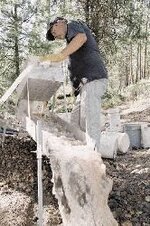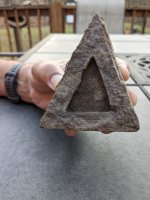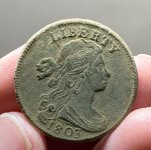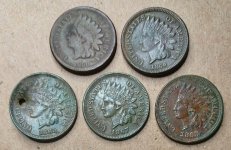Gypsy Heart
Gold Member
Published: July 21, 2006
Ted Schadewitz uses a high banker to separate gold from sand and gravel. "These guys don't realize I've got a real good gold mine over here," he confided. The high banker allows someone to sort out gold by pumping water through a hose.
Baker City Herald/Alex Pajunas
By ALEX PAJUNAS
[email protected]
Traveling along dusty Old Auburn Road will take you past farms and a wildlife viewing station to the site of the ghost town of Auburn. During the towns peak in the late 1800s it had a population around 6,000, one of the largest in Oregon. When the gold dried up so did the town.
Eastern Oregon's gold rush has long been gone, but Auburn has come back to life. Pack horses have been replaced by large RVs and campers. Instead of celebrating a day's work with dancing and a drink from a keg of whiskey at the saloon, you can find someone looking at recent mining photos drinking from a can of Keystone Light.
Though much of the gold has already been found, the hopeful spirit and gold-fevered determination still runs strong among the mining members of the Eastern Oregon Miners and Prospectors.
"There's nothing like going out and digging something that has been in the ground for thousands of years," said Ted Schadewitz, a carpenter from Baker City. "It's hard work to get it and one needs to know what they are doing and looking for."
Each month the EOMP has what they call a "rendezvous" where members spend a weekend at one of the organizations eight different claims. The atmosphere is about as close as you can come to reliving the experience of an old mining camp.
"Oh it's a lot of fun, the friendship and camaraderie is tremendous," said Forrest Noland, President of the EOMP. "Everyone helps everyone. Hardly an argument or anything, and if there is one it's about ‘let me do the heavy work.'"
This differs from the rough and tumble ways often associated with the early miners and a scene, described in the book "Gold, Jade and Elegance" written by Helen B. Rand, in which actors from a theater performance made fun of some local characters in the mining camp. Guns and knives were drawn, but the only ones hurt were the drunks who got mixed up with the city defenders.
The EOMP miners prefer more civil means of entertainment during their rendezvous. Friday night involved a potluck, while Saturday welcomed speaker Terry Drever-Gee to speak on the issue of post-mining land reclamation .
"It was really the best one we've ever had; the most successful," said Noland of the 35 families that came over the weekend. "We have done some extensive mining out there this spring and we are getting good gold."
If the rendezvous was so successful, you may wonder exactly how much gold was found?
"You can't get that answer out of a miner. Ask a miner ‘how did you do?' ‘Oh we got some,' said Noland. "When you think about it, it's like asking ‘how much money do you have?'"
The EOMP rendezvous officially ended Sunday, but a visit to the Auburn claim this past Wednesday revealed miners still at work. Five-gallon buckets and hoses layed among the lawn chairs, while Schadewitz sorted out gold by scooping gravel into a high banker above a pond created by water transported by hose from a nearby spring.
According to Schadewitz you can sort through 60 to 70 five-gallon buckets of rock a day using a high banker, a piece of equipment which allows miners to filter the lightweight sand and rock from the gold. The machine allows a miner to work farther away from water through the use of a hose.
An even larger scale machine, called a trommel, allows miners to sort gold from up to 400 buckets of ore in a day. Entire buckets can be poured into the trommel at one time, where the rock travels through a spinning tube that sprays water through the grated tube in order to filter out the gold.
But the technology used by the modern miner does not end there. Also at their disposal is the Minelab metal detector.
Loye Blackburn, who runs Back Country Prospectors from a trailer along Cracker Creek in Sumpter during the summer, said the detector has contracts with the U.N. and NATO because of its ability to detect a small metal firing pin found in plastic land mines. That same technology is used in their gold detectors, which means for nearly $4,000 you stand a good chance of finding a gold nugget.
Blackburn still has a variety of gold pans for sale, but hates using them because of his "biggest seller:" the automatic gold pan. Utilizing a spiral pan, a miner puts a scoop of sand into the spinning pan. Within a few minutes the heavier gold, spirals its way to a collection cup in the middle.
"(The automatic gold pan) is good for checking an area to determine if it's worth working," said Blackburn "Its 50 times faster than the average person panning."
Due to the fact that Oregon's first generation of miners relied mainly on a simple metal pan and sluice box, they were not nearly as efficient as today's miners.
"We are still getting gold right where they mined," said Noland. "But they weren't after the little stuff. They were after the big stuff; the cream of the crop. They didn't work it down clean. There isn't going to be anything left after we work it with our equipment."
Many came looking for the big stuff shortly after word spread in 1861 that there was gold in Eastern Oregon. These miners were the first white settlers to establish communities in the area. Since no infrastructure existed at the time, travel was difficult and heavy equipment could not be brought in. Placer mining was a significant technique in the discovery of gold as it involved sifting through loose rock and gravel along creeks, flood plains and rivers without the use of heavy equipment.
"Anything more advanced than that you had to have help," said Howard Brooks, the co-author of "Gold and Silver in Oregon." "Besides that, working alone was extremely dangerous because of Indians and if you got sick or had any kind of a mishap you were totally on your own. Of course you had to be tough.
"Some people did go by themselves, but there are stories of loners losing whatever gold they had to robbers, or losing their horses and gear to Indians. So it was just not a good idea to work alone."
Placer production began to decrease in the 1880s, but the arrival of the Union Pacific Railroad allowed heavier and more advanced mining equipment to be shipped into the region.
Miners could now begin tracing veins of gold they found deep into underground mines. Using steam engines to provide compressed air, jackhammers could drill holes for dynamite to blast apart hard rock. The compressed air could then be used to power hoists brining the rock to the surface where it could be processed in a stamp or Chilean mill, which could smash or grind gold veins from rock.
According to "Gold and Silver in Oregon," many gold mines had closed by 1911. But it was the 1942 War Production Board Order L-208 that most effectively put an end to underground gold mining in Oregon.
The order, lasting from 1942-1945, called for gold mines to stop operation in order for the men and equipment to focus their work on the war effort.
"They thought that gold wasn't worth allowing people to mine when they could be building bombs, or airplanes, stuff like that," said Brooks, who retired from the Oregon Department of Geology and Mineral Industries in 1991.
"If the cost of production had not gone up so scandalously much in the few years during the war and shortly after, some of the mines probably would have reopened," said Brooks. "The government held the price of gold at $35 while the cost of production escalated."
"(During) that lull in mining, a lot of the properties went down hill," said Nils Christensen, who is the President of the Cracker Creek Mining Museum which contains examples of the old equipment used in association with the mines. "The underground (mines were) not maintained and it just became too costly."
Effort to reopen some mines have mostly resulted in multi million dollar losses. Unless the price of gold reaches $800 an ounce for an extended period of time Brooks doesn't see a future in reopening old mines.
"Some of the mines would probably have quite a bit of gold, but can you mine it at a profit?" said Brooks. "To go back into it and reopen some of those mines would be terribly expensive, like in the millions of dollars."
Currently most large-scale gold operations involve open pit mining in areas like Nevada and California.
"Some of the bigger ones are tens of thousands of tons a day in production so they can work very low grade ore," said Brooks. "Some (open pit mines) are two to three tenths of an ounce per ton."
While the miners of the past did not have the advanced technology that allows today's miners to supplement their income and in some cases make a living, they did not have to face much government regulation.
The only rules that existed in the old mining districts were those settled upon by popular vote and nailed to a prominent tree in town. The rules varied from town to town. According to Gold, Jade and Elegance, the rules of Canyon City allowed prospectors to have one claim in a creek, ravine, or hill, and one along a river. A third claim could be purchased.
Claims could be lost if they were not regularly worked upon. But a miner was excused in cases of illness or absence while fighting in an Indian war.
"In the earlier days you just went out and mined," said Christensen. "Now it's not that way. To abide by all the criteria, it's just almost impossible, unless you have an extremely rich property or a fairly high volume operation.
"(Rules) are a thorn in the side of a lot of people. There's pros and cons. I can see both sides of it. I mined for a lot of years. You can see, in the early days there were a lot of things that were done that certainly weren't helpful to the environment, but mining wasn't the only thing.
"They kind of came down on the miners and now people are really trying. The people out there mining are really trying very hard to abide by all of the things that people feel that are necessary to do."
Despite the challenges faced by local miners, the number of people interested in gold mining is increasing.
"We have more than doubled in the last two years," said Noland. "We have about 110 families (who are members of the EOMP)."
An annual family membership costs $50 and allows access to all eight of the EOMP's claims and keep all that you find.
http://www.bakercityherald.com/news/story.cfm?story_no=3688
Ted Schadewitz uses a high banker to separate gold from sand and gravel. "These guys don't realize I've got a real good gold mine over here," he confided. The high banker allows someone to sort out gold by pumping water through a hose.
Baker City Herald/Alex Pajunas
By ALEX PAJUNAS
[email protected]
Traveling along dusty Old Auburn Road will take you past farms and a wildlife viewing station to the site of the ghost town of Auburn. During the towns peak in the late 1800s it had a population around 6,000, one of the largest in Oregon. When the gold dried up so did the town.
Eastern Oregon's gold rush has long been gone, but Auburn has come back to life. Pack horses have been replaced by large RVs and campers. Instead of celebrating a day's work with dancing and a drink from a keg of whiskey at the saloon, you can find someone looking at recent mining photos drinking from a can of Keystone Light.
Though much of the gold has already been found, the hopeful spirit and gold-fevered determination still runs strong among the mining members of the Eastern Oregon Miners and Prospectors.
"There's nothing like going out and digging something that has been in the ground for thousands of years," said Ted Schadewitz, a carpenter from Baker City. "It's hard work to get it and one needs to know what they are doing and looking for."
Each month the EOMP has what they call a "rendezvous" where members spend a weekend at one of the organizations eight different claims. The atmosphere is about as close as you can come to reliving the experience of an old mining camp.
"Oh it's a lot of fun, the friendship and camaraderie is tremendous," said Forrest Noland, President of the EOMP. "Everyone helps everyone. Hardly an argument or anything, and if there is one it's about ‘let me do the heavy work.'"
This differs from the rough and tumble ways often associated with the early miners and a scene, described in the book "Gold, Jade and Elegance" written by Helen B. Rand, in which actors from a theater performance made fun of some local characters in the mining camp. Guns and knives were drawn, but the only ones hurt were the drunks who got mixed up with the city defenders.
The EOMP miners prefer more civil means of entertainment during their rendezvous. Friday night involved a potluck, while Saturday welcomed speaker Terry Drever-Gee to speak on the issue of post-mining land reclamation .
"It was really the best one we've ever had; the most successful," said Noland of the 35 families that came over the weekend. "We have done some extensive mining out there this spring and we are getting good gold."
If the rendezvous was so successful, you may wonder exactly how much gold was found?
"You can't get that answer out of a miner. Ask a miner ‘how did you do?' ‘Oh we got some,' said Noland. "When you think about it, it's like asking ‘how much money do you have?'"
The EOMP rendezvous officially ended Sunday, but a visit to the Auburn claim this past Wednesday revealed miners still at work. Five-gallon buckets and hoses layed among the lawn chairs, while Schadewitz sorted out gold by scooping gravel into a high banker above a pond created by water transported by hose from a nearby spring.
According to Schadewitz you can sort through 60 to 70 five-gallon buckets of rock a day using a high banker, a piece of equipment which allows miners to filter the lightweight sand and rock from the gold. The machine allows a miner to work farther away from water through the use of a hose.
An even larger scale machine, called a trommel, allows miners to sort gold from up to 400 buckets of ore in a day. Entire buckets can be poured into the trommel at one time, where the rock travels through a spinning tube that sprays water through the grated tube in order to filter out the gold.
But the technology used by the modern miner does not end there. Also at their disposal is the Minelab metal detector.
Loye Blackburn, who runs Back Country Prospectors from a trailer along Cracker Creek in Sumpter during the summer, said the detector has contracts with the U.N. and NATO because of its ability to detect a small metal firing pin found in plastic land mines. That same technology is used in their gold detectors, which means for nearly $4,000 you stand a good chance of finding a gold nugget.
Blackburn still has a variety of gold pans for sale, but hates using them because of his "biggest seller:" the automatic gold pan. Utilizing a spiral pan, a miner puts a scoop of sand into the spinning pan. Within a few minutes the heavier gold, spirals its way to a collection cup in the middle.
"(The automatic gold pan) is good for checking an area to determine if it's worth working," said Blackburn "Its 50 times faster than the average person panning."
Due to the fact that Oregon's first generation of miners relied mainly on a simple metal pan and sluice box, they were not nearly as efficient as today's miners.
"We are still getting gold right where they mined," said Noland. "But they weren't after the little stuff. They were after the big stuff; the cream of the crop. They didn't work it down clean. There isn't going to be anything left after we work it with our equipment."
Many came looking for the big stuff shortly after word spread in 1861 that there was gold in Eastern Oregon. These miners were the first white settlers to establish communities in the area. Since no infrastructure existed at the time, travel was difficult and heavy equipment could not be brought in. Placer mining was a significant technique in the discovery of gold as it involved sifting through loose rock and gravel along creeks, flood plains and rivers without the use of heavy equipment.
"Anything more advanced than that you had to have help," said Howard Brooks, the co-author of "Gold and Silver in Oregon." "Besides that, working alone was extremely dangerous because of Indians and if you got sick or had any kind of a mishap you were totally on your own. Of course you had to be tough.
"Some people did go by themselves, but there are stories of loners losing whatever gold they had to robbers, or losing their horses and gear to Indians. So it was just not a good idea to work alone."
Placer production began to decrease in the 1880s, but the arrival of the Union Pacific Railroad allowed heavier and more advanced mining equipment to be shipped into the region.
Miners could now begin tracing veins of gold they found deep into underground mines. Using steam engines to provide compressed air, jackhammers could drill holes for dynamite to blast apart hard rock. The compressed air could then be used to power hoists brining the rock to the surface where it could be processed in a stamp or Chilean mill, which could smash or grind gold veins from rock.
According to "Gold and Silver in Oregon," many gold mines had closed by 1911. But it was the 1942 War Production Board Order L-208 that most effectively put an end to underground gold mining in Oregon.
The order, lasting from 1942-1945, called for gold mines to stop operation in order for the men and equipment to focus their work on the war effort.
"They thought that gold wasn't worth allowing people to mine when they could be building bombs, or airplanes, stuff like that," said Brooks, who retired from the Oregon Department of Geology and Mineral Industries in 1991.
"If the cost of production had not gone up so scandalously much in the few years during the war and shortly after, some of the mines probably would have reopened," said Brooks. "The government held the price of gold at $35 while the cost of production escalated."
"(During) that lull in mining, a lot of the properties went down hill," said Nils Christensen, who is the President of the Cracker Creek Mining Museum which contains examples of the old equipment used in association with the mines. "The underground (mines were) not maintained and it just became too costly."
Effort to reopen some mines have mostly resulted in multi million dollar losses. Unless the price of gold reaches $800 an ounce for an extended period of time Brooks doesn't see a future in reopening old mines.
"Some of the mines would probably have quite a bit of gold, but can you mine it at a profit?" said Brooks. "To go back into it and reopen some of those mines would be terribly expensive, like in the millions of dollars."
Currently most large-scale gold operations involve open pit mining in areas like Nevada and California.
"Some of the bigger ones are tens of thousands of tons a day in production so they can work very low grade ore," said Brooks. "Some (open pit mines) are two to three tenths of an ounce per ton."
While the miners of the past did not have the advanced technology that allows today's miners to supplement their income and in some cases make a living, they did not have to face much government regulation.
The only rules that existed in the old mining districts were those settled upon by popular vote and nailed to a prominent tree in town. The rules varied from town to town. According to Gold, Jade and Elegance, the rules of Canyon City allowed prospectors to have one claim in a creek, ravine, or hill, and one along a river. A third claim could be purchased.
Claims could be lost if they were not regularly worked upon. But a miner was excused in cases of illness or absence while fighting in an Indian war.
"In the earlier days you just went out and mined," said Christensen. "Now it's not that way. To abide by all the criteria, it's just almost impossible, unless you have an extremely rich property or a fairly high volume operation.
"(Rules) are a thorn in the side of a lot of people. There's pros and cons. I can see both sides of it. I mined for a lot of years. You can see, in the early days there were a lot of things that were done that certainly weren't helpful to the environment, but mining wasn't the only thing.
"They kind of came down on the miners and now people are really trying. The people out there mining are really trying very hard to abide by all of the things that people feel that are necessary to do."
Despite the challenges faced by local miners, the number of people interested in gold mining is increasing.
"We have more than doubled in the last two years," said Noland. "We have about 110 families (who are members of the EOMP)."
An annual family membership costs $50 and allows access to all eight of the EOMP's claims and keep all that you find.
http://www.bakercityherald.com/news/story.cfm?story_no=3688
Amazon Forum Fav 👍
Attachments
Upvote
0



 ?? i know i donate to the EOMA in their attempt to protect our mining rights in oregon!
?? i know i donate to the EOMA in their attempt to protect our mining rights in oregon!


